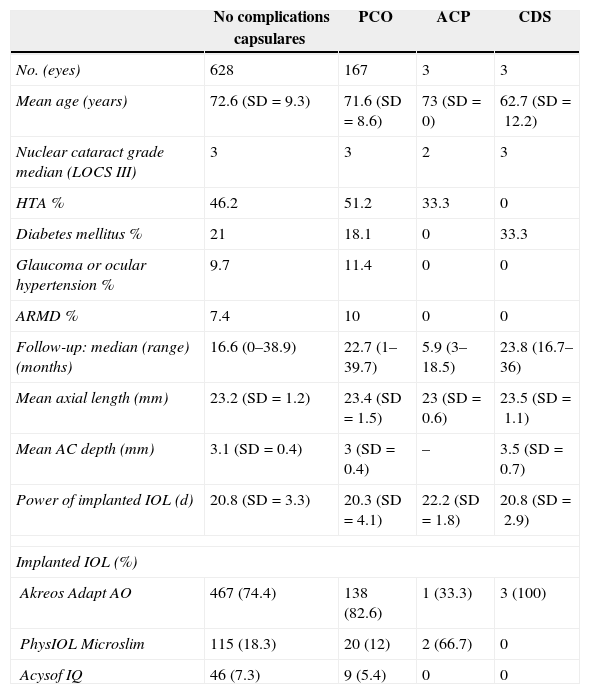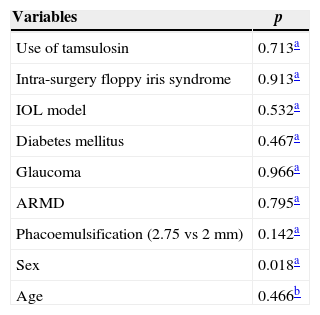To determine the incidence and the risk factors involved in the development of the three main postoperative capsular complications: posterior capsule opacification (PCO), capsular bag distension syndrome (CBDS), and anterior capsular phimosis syndrome (ACP).
Subjects, materials and methodsA retrospective cohort study was conducted on 801 patients submitted to cataract surgery in the ophthalmology unit of Hospital del Henares (Madrid) from March 2, 2009 to February 28, 2010. Computerized clinical charts were reviewed during July 2012. PCO was studied using the Kaplan–Meier method (log rank test).
ResultsA total of 167 patients developed PCO. No association could be demonstrated between PCO and age, sex, diabetes mellitus, phaco technique, IOL model, tamsulosin intake, glaucoma, and age-related macular degeneration. Three patients developed CBDS, all of them have received a Akreos Adapt AO® (Bausch & Lomb). Two of them were young men who had received surgery for posterior subcapsular cataracts. Three patients developed ACP, 2 of whom had received a MicroSlim® IOL (PhysIOL).
ConclusionsNo association was found between PCO and any of the studied variables. Male gender, young age, subcapsular cataract and large non-angulated lens such as Akreos Adapt AO® could be associated with CBDS. ACP could be more frequent when microincision IOLs (like MicroSlim®) are implanted.
Determinar la incidencia y los factores de riesgo implicados en el desarrollo de las tres principales complicaciones capsulares postoperatorias: opacificación de cápsula posterior (OCP), síndrome de distensión capsular (SDC) y fimosis de la cápsula anterior (FCA).
Sujetos, material y métodosEstudio de cohortes retrospectivo. Se incluyó a 801 pacientes operados mediante cirugía de catarata en el Servicio de Oftalmología del Hospital del Henares (Madrid), entre el 2 de marzo de 2009 y el 28 de febrero de 2010. La historia clínica electrónica fue revisada durante el mes de julio de 2012. La OCP se estudió utilizando el método de Kaplan–Meier (log rank test).
ResultadosUn total de 167 pacientes desarrollaron OCP. No se pudo demostrar asociación entre la OCP y edad, sexo, diabetes mellitus, técnica de facoemulsificación, modelo de lente intraocular (LIO), consumo de tamsulosina, grado de síndrome de iris flácido intraoperatorio, glaucoma ni la degeneración macular asociada a la edad. Tres pacientes desarrollaron SDC, todos ellos habían recibido una LIO Akreos Adapt AO® (Bausch & Lomb). Dos de ellos eran varones jóvenes, con diagnóstico de catarata subcapular posterior. Tres pacientes desarrollaron FCA, dos de ellos habían recibido una LIO MicroSlim® (PhysIOL).
ConclusionesNo pudo demostrarse asociación de la OCP con ninguna de las variables estudiadas. El sexo masculino, la edad joven, la catarata subcapsular posterior y las LIO grandes no anguladas como la Akreos Adapt AO® podrían asociarse al desarrollo de SDC. Las LIO de microincisión, como la MicroSlim®, podrían asociarse al desarrollo de FCA.








